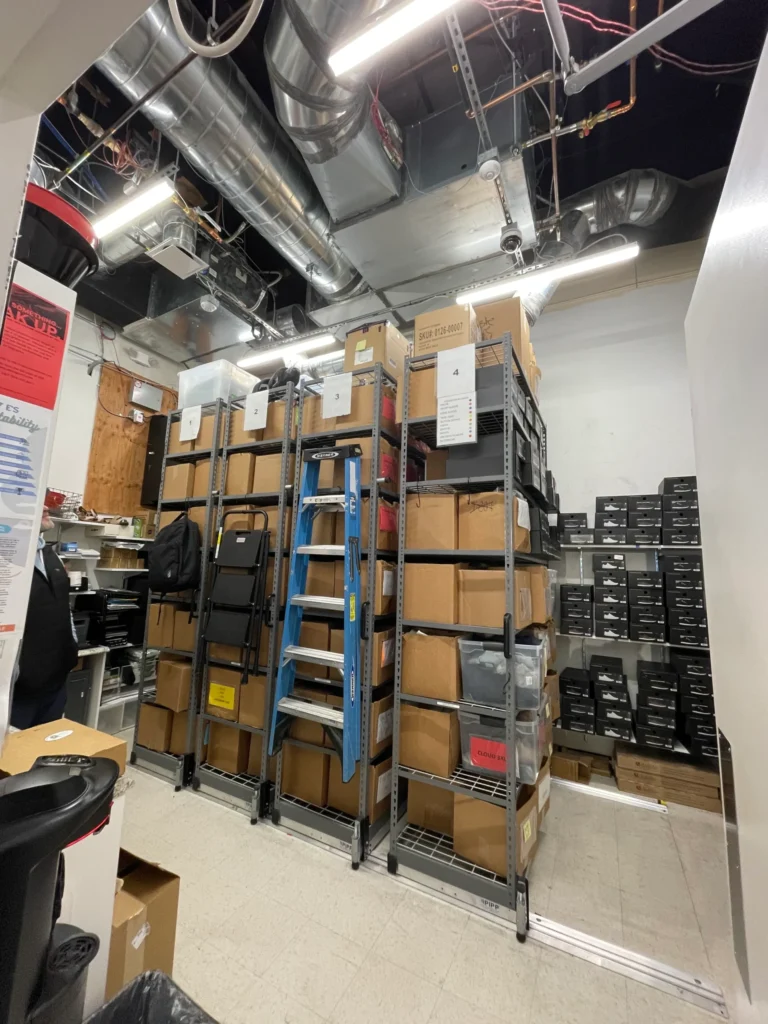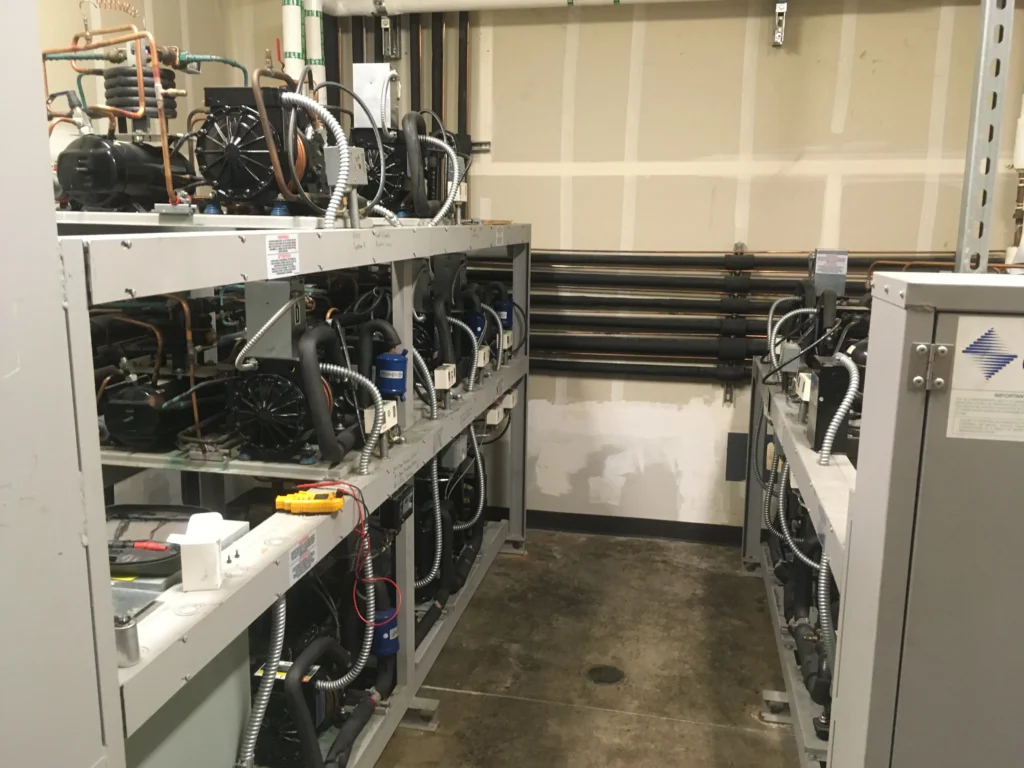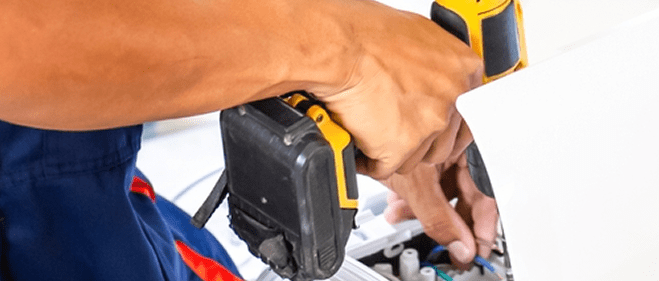Commercial Server Room Cooling Services
Table of Contents
Commercial Server Room & Data Center Cooling Solutions
Your IT infrastructure represents the beating heart of your business operations. Every server, switch, and storage device generates significant heat while processing critical data that keeps your organization running. When cooling systems fail, the consequences extend far beyond equipment replacement costs—data loss, network downtime, and operational paralysis can cost thousands per minute.
Server room cooling isn’t just about maintaining comfortable temperatures. It’s about precision climate control that protects millions of dollars in equipment while ensuring the reliability and performance your business depends on. Modern data centers and server rooms require specialized cooling solutions that balance energy efficiency with uncompromising protection.
This guide reveals why precision cooling is non-negotiable for IT infrastructure, explores tailored solutions for different environments, and demonstrates how energy-efficient designs deliver both protection and cost savings for your critical systems.

Importance of Precision Cooling for IT Infrastructure
IT equipment operates within extremely narrow temperature and humidity ranges that traditional HVAC systems simply cannot maintain consistently. Server processors, storage drives, and networking equipment generate concentrated heat loads that require immediate removal to prevent performance degradation and catastrophic failures.
The American Society of Heating, Refrigerating and Air-Conditioning Engineers (ASHRAE) recommends server inlet temperatures between 64.4°F and 80.6°F with relative humidity between 40-60%. Deviating from these parameters dramatically increases failure rates and reduces equipment lifespan.
Prevent Downtime, Overheating, Equipment Failure
Equipment overheating causes immediate performance throttling and long-term reliability problems that cost businesses millions annually. Modern servers automatically reduce processing speed when internal temperatures exceed safe thresholds, directly impacting application performance and user experience.
A single degree increase above optimal operating temperature reduces server reliability by 50% and shortens equipment life by approximately two years. For a data center with $500,000 in server equipment, overheating can eliminate $250,000 in asset value while triggering premature replacement cycles.
Hard drive failure rates triple when operating temperatures exceed manufacturer specifications. Storage systems containing irreplaceable business data face exponentially higher failure risks without proper cooling. A single drive failure can cascade into complete array failures that destroy years of critical information.
Network downtime from cooling failures costs businesses an average of $5,600 per minute according to industry studies. E-commerce sites lose revenue directly, while manufacturing operations halt production. Financial services firms face regulatory penalties for system unavailability that compounds direct revenue losses.
Unplanned downtime events average 3-4 hours to resolve, resulting in $1-2 million losses for medium-sized businesses. Planned maintenance windows minimize these impacts, but cooling system failures create extended outages that can exceed 24 hours when emergency repairs require specialized parts or equipment.
Cascading equipment failures multiply initial problems into facility-wide disasters. When one cooling unit fails, remaining systems experience increased loads that can trigger additional failures. This domino effect transforms minor cooling problems into complete data center shutdowns.
Backup power systems, including uninterruptible power supplies (UPS) and generators, also generate significant heat that cooling systems must handle. During power outages, backup systems create additional thermal loads exactly when cooling capacity may be compromised.
Humidity control failures damage equipment through static discharge or condensation formation. Low humidity creates electrostatic discharge that destroys sensitive electronic components, while high humidity causes condensation that creates short circuits and corrosion.
Tailored Server Room Cooling Installations
Different server environments require specific cooling approaches based on heat density, room layout, equipment types, and redundancy requirements. One-size-fits-all cooling solutions fail to address the unique challenges that various IT installations present.
Professional cooling system design considers current heat loads while planning for future expansion and equipment changes. This forward-thinking approach prevents costly modifications when businesses add servers or upgrade networking equipment.
CRAC Units, Airflow Optimization, Redundancy Planning
Computer Room Air Conditioning (CRAC) units provide precision cooling specifically designed for IT environments. Unlike standard HVAC systems, CRAC units maintain exact temperature and humidity levels while filtering air to prevent contamination damage.
CRAC systems typically achieve ±2°F temperature control compared to ±5-10°F for conventional HVAC systems. This precision prevents thermal cycling that stresses electronic components and extends equipment life significantly. Precision humidity control maintains 45-55% relative humidity that optimizes static discharge protection.
Sizing calculations for CRAC units consider both current and projected heat loads. IT equipment heat output, lighting systems, and human occupancy all contribute to cooling requirements. Professional designers add 20-30% capacity margins to handle future expansion without system modifications.
Multiple smaller CRAC units often provide better coverage than single large units. Distributed cooling prevents hot spots while providing redundancy that maintains cooling even when individual units fail. This approach also enables maintenance without complete system shutdown.
Strategic airflow optimization maximizes cooling efficiency while minimizing energy consumption. Hot aisle/cold aisle configurations separate equipment intake and exhaust air to prevent mixing that reduces cooling effectiveness.
Raised floor systems enable under-floor air distribution that delivers cool air directly to server intakes. Perforated floor tiles position cooling air precisely where needed while return air systems capture hot exhaust efficiently. This approach can reduce cooling energy consumption by 20-40%.
Containment systems physically separate hot and cold air streams to prevent mixing. Cold aisle containment systems enclose server intakes within cool air environments, while hot aisle containment captures exhaust heat directly. Both approaches improve cooling efficiency substantially.
Computational fluid dynamics (CFD) modeling optimizes airflow patterns before construction begins. This analysis identifies potential hot spots and airflow problems that design modifications can address proactively. CFD modeling prevents expensive corrections after installation completion.
Comprehensive redundancy planning ensures cooling continues even when primary systems fail. N+1 redundancy provides backup cooling capacity equal to the largest single cooling unit. This approach maintains full cooling capacity even when one unit requires maintenance or experiences failure.
2N redundancy duplicates the entire cooling system to provide complete backup capability. This approach offers maximum protection for mission-critical applications that cannot tolerate any cooling capacity reduction. Financial trading floors and emergency dispatch centers often require 2N redundancy.
Automatic failover systems detect cooling unit failures and activate backup systems immediately. These systems monitor temperature, humidity, and airflow to identify problems before they affect IT equipment. Response times under 30 seconds prevent temperature excursions that could damage equipment.
Emergency cooling procedures prepare facilities for extended cooling system outages. Portable cooling units, emergency generators, and equipment shutdown protocols minimize damage when primary and backup systems fail simultaneously.

Maintenance & Rapid Repair for Critical Cooling
Server room cooling systems require more frequent and specialized maintenance than standard HVAC equipment. The critical nature of IT cooling means that preventive maintenance and rapid repair capabilities are essential for business continuity.
Professional maintenance programs address the unique requirements of precision cooling systems while ensuring maximum uptime for critical IT infrastructure. These programs combine routine preventive care with emergency response capabilities.
Off-Hour Service, Fast Response, Emergency Support
Off-hours maintenance scheduling prevents service work from disrupting business operations or IT system availability. Most server rooms and data centers operate continuously, making after-hours maintenance essential for avoiding operational impacts.
Scheduled maintenance during planned downtime windows coordinates cooling service with IT maintenance activities. This coordination maximizes maintenance efficiency while minimizing total system downtime. Professional technicians work quickly during these limited windows to complete all necessary service work.
Weekend and holiday service ensures cooling systems receive attention when facilities have minimal occupancy. These periods often provide the only opportunities for major maintenance activities that require temporary cooling system shutdown.
Rapid emergency response minimizes equipment damage and business disruption when cooling failures occur. Professional service providers maintain 24/7 emergency response capabilities with guaranteed response times for critical cooling systems.
Emergency parts inventory enables immediate repairs without waiting for parts delivery. Common failure components like compressors, fans, and control systems are stocked locally for immediate replacement. This preparation reduces emergency repair time from days to hours.
On-call technician programs ensure qualified service personnel are available immediately when cooling emergencies occur. These technicians carry specialized tools and diagnostic equipment needed for emergency cooling system repairs.
Emergency temporary cooling services provide immediate protection while permanent repairs are completed. Portable cooling units can maintain critical server room conditions during extended repair periods. These temporary solutions prevent equipment damage and business disruption.
Comprehensive emergency support includes both technical expertise and coordination services that minimize business impact. Emergency support teams coordinate with IT staff, facility managers, and equipment vendors to ensure effective response.
Emergency communication protocols keep stakeholders informed about repair progress and expected completion times. Regular updates help businesses plan around cooling system outages and coordinate backup procedures effectively.
Priority parts sourcing accelerates repair completion by securing replacement components quickly. Professional service providers maintain relationships with equipment manufacturers and parts suppliers that enable expedited delivery when standard inventory is insufficient.

Emergency HVAC Issues We Fix
Your system may need urgent attention if you’re experiencing:
- No airflow from vents
- Furnace blowing cold air
- AC blowing warm air
- System won’t turn on
- Iced-over AC or refrigerant line
- Thermostat not responding
- Loud, unusual noises from the unit
- Weak airflow or poor indoor air quality
- Water leaks around the unit
- Burning smells or electrical odor
- Complete system failure
If you notice any of these signs, don’t wait. Contact COOL AID for immediate HVAC help.
Efficiency Meets Reliability in IT Cooling
Modern server room cooling systems achieve remarkable energy efficiency without compromising the reliability that critical IT infrastructure demands. Advanced technologies enable precise temperature control while reducing operating costs significantly compared to older cooling approaches.
The balance between efficiency and reliability requires careful system design and component selection. Professional cooling specialists understand how to optimize both parameters without sacrificing either requirement.
Energy-Saving Designs, Monitoring & Scheduled Checks
Advanced energy-saving technologies reduce cooling costs while maintaining precision control. Variable speed compressors adjust cooling output to match actual heat loads, eliminating the energy waste that fixed-speed systems create during partial load conditions.
Free cooling systems use outside air during favorable weather conditions to reduce mechanical cooling requirements. Economizer systems can provide 20-40% energy savings in moderate climates by using cool outdoor air for data center cooling when ambient temperatures permit.
High-efficiency heat exchangers improve cooling system performance while reducing energy consumption. Microchannel coils and enhanced heat transfer surfaces enable more effective heat rejection with smaller equipment footprints and reduced fan power requirements.
Smart control systems optimize cooling system operation based on real-time conditions and occupancy patterns. These systems can reduce energy consumption by 15-25% through intelligent staging of cooling equipment and optimization of airflow patterns.
Comprehensive monitoring systems provide real-time visibility into cooling system performance and IT environment conditions. Temperature and humidity sensors throughout server rooms enable precise monitoring and early problem detection.
Remote monitoring capabilities enable 24/7 oversight of critical cooling systems from centralized monitoring centers. Professional monitoring services can detect problems and dispatch technicians before cooling failures affect IT equipment.
Trend analysis identifies gradual performance degradation that routine checks might miss. Monitoring data reveals patterns that indicate impending equipment failures or system inefficiencies that proactive maintenance can address.
Alarm systems provide immediate notification when cooling parameters exceed acceptable ranges. These alarms enable rapid response that prevents minor problems from becoming major failures.
Proactive scheduled maintenance prevents cooling system failures while optimizing energy efficiency and equipment life. Regular filter changes, coil cleaning, and mechanical adjustments maintain peak performance while preventing degradation.
Quarterly inspections identify wear patterns and potential problems before they cause failures. These inspections include electrical connections, refrigerant levels, airflow measurements, and control system calibration that ensure optimal performance.
Annual comprehensive service includes detailed component inspection, performance testing, and preventive component replacement. This thorough service addresses wear items before they fail while optimizing system efficiency for the coming year.
Performance optimization services fine-tune cooling systems for maximum efficiency while maintaining required reliability. These services can identify efficiency improvements that reduce operating costs without compromising IT equipment protection.
Protect Your Most Critical Business Assets
Your IT infrastructure represents the foundation of modern business operations. Every server, storage device, and network component requires precise cooling to deliver the reliability and performance your organization depends on.
Don’t risk your critical business systems with inadequate cooling solutions. Professional server room cooling combines precision control with energy efficiency to protect your technology investments while controlling operating costs.
The cost of proper server room cooling is minimal compared to the losses that equipment failures and downtime create. Professional cooling solutions deliver both immediate protection and long-term value through reduced energy costs and extended equipment life.
Ready to protect your IT infrastructure with professional server room cooling solutions? Contact 1800coolaid.com today for expert consultation on precision cooling systems designed specifically for your Bay Area business needs. Our certified technicians specialize in server room and data center cooling that delivers uncompromising reliability while optimizing energy efficiency. Don’t let cooling failures threaten your business success—invest in the precision cooling your critical systems deserve.
Frequently Asked Questions
What temperature should I maintain in my server room?
Server rooms should maintain inlet temperatures between 64.4°F and 80.6°F per ASHRAE guidelines, with relative humidity between 40-60%. Precision cooling systems can maintain these parameters within ±2°F, ensuring optimal equipment performance and longevity.
How often should server room cooling systems be serviced?
Precision cooling systems require quarterly maintenance due to their critical nature and continuous operation. This includes filter changes, coil cleaning, and performance verification. Annual comprehensive service addresses all major components and optimization opportunities.
What happens if my server room cooling fails?
Cooling failures can cause equipment overheating within minutes, leading to performance throttling, data loss, and hardware damage. Our emergency response team provides 24/7 support with guaranteed response times to minimize downtime and protect your IT infrastructure.
Serving the Entire Bay Area
We proudly serve customers in:
